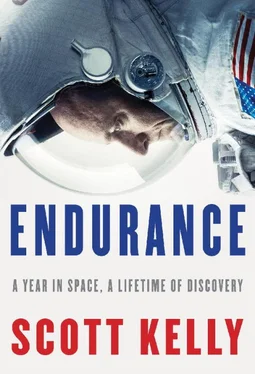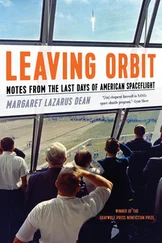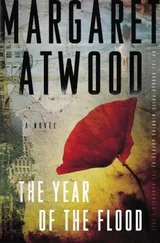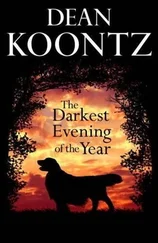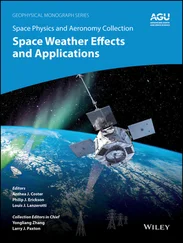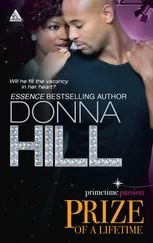Since the debris field was so large, the pieces of the orbiter couldn’t all be recovered on foot. A couple of weeks later, I was put in charge of directing an air search, using airplanes and helicopters to locate the larger pieces. You would think a piece of a spacecraft would be instantly recognizable, even from the air, but we wasted time investigating old cars, bathtubs, rusted-out appliances, and all kinds of garbage that, from a distance, looked like it could have come from the shuttle. There were rumors of remains of murder victims found during the search, and sites the searchers thought looked like methamphetamine labs, though I could never determine whether these rumors were true.
Of the debris we did find from Columbia, some of it was strangely undamaged. I found the space shuttle’s Canon printer lying in the woods without a scratch on it—the same model of printer that I would later struggle with while living on the space station. We found samples from science experiments the crew had worked on, still intact—so much so that scientists could complete some of the research goals of the mission. A petri dish full of worms even survived the disaster.
Every day I was out searching, the Salvation Army was out there too, providing food and coffee, offering any kind of help they could. Ever since, I never walk by their ringing bells at Christmastime without putting something in the red kettle.
A few of the astronaut doctors worked in the local morgue, safeguarding the remains of our fallen colleagues as they awaited transport. Eventually I escorted Laurel’s body from the morgue to Barksdale Air Force Base in a Black Hawk helicopter. As I climbed out of the helicopter, I was surprised to see an Air Force general in full dress uniform saluting sharply, behind him a full formation of officers and airmen at attention. I was moved by their show of respect while the flag-draped casket was carried into the hangar. Later, Laurel’s remains were transferred to an aircraft to be flown to Dover Air Force Base in Delaware, the military’s mortuary, for a forensic autopsy.
As the search went on, a second tragedy occurred: a Forest Service helicopter crashed while searching for debris. Two people were killed and three more were injured. The ensuing investigation revealed that the pilot was flying outside the operating limits for the aircraft, maybe in an effort to get to a hard-to-reach area. No one talked about calling off the search for debris and remains, but this was another sobering reminder of the risks inherent in aviation.
Three of the crew were buried at Arlington National Cemetery, and other funerals were held in the crew members’ home states. NASA hired or borrowed airplanes to take those of us closest to the crew to Arlington and to the other funerals. On a blustery day that would have been Laurel’s forty-second birthday, she was laid to rest next to two of her Columbia crewmates. Seeing the pageantry of the full military honors, and the finality of her casket lowered into the ground, I absorbed fully the loss we had suffered and became more aware than ever of the risks we were taking traveling into space. I had lost friends and colleagues to airplane crashes many times before. I’d stopped keeping an exact count when the number got into the thirties; it is now in the forties—but I had never lost anyone as close to me as Laurel Blair Clark.
I can honestly say the Columbia accident never for a second made me think about quitting. But my colleagues’ deaths gave me a renewed sense that my daughter could have grown up without a parent, just as the Columbia crew’s kids have done. The shuttle program had been suspended until the accident investigation board could come to a conclusion about what had happened, so I didn’t have much to do for the next six months. Eventually I was named chief of the Space Station Integration Branch, heading up a group of astronauts and engineers making decisions about hardware and procedures for the International Space Station, which had now been inhabited nonstop for more than two years. (It was still small and rudimentary compared to the expanded station I would visit in the future.) I was learning everything I could about how to make the station work most efficiently and effectively.
In August 2003, the Columbia Accident Investigation Board submitted its findings. It did not call for the shuttle program to shut down completely, as some had feared. But it would not be allowed to continue forever. The board recommended that after the assembly of the International Space Station was complete, planned for 2010, the shuttle orbiters should be recertified in order to keep flying. This process would require dismantling and rebuilding all three orbiters from the ground up. Recertification would be so complex and expensive there was no way NASA would be able to get Congress to pay for it, so we knew that most likely the shuttle would be scrapped. Besides, NASA wanted to focus on a new exploration vehicle (the project that has now become the Space Launch System and Orion) and wouldn’t be able to fund it properly while supporting both the space shuttle and the space station. The shuttle program would be the one to go. I agreed with that decision, though I knew I would miss it.
—
IN OCTOBER 2003, Leslie gave birth to our second child, Charlotte. The birth shaped up to be even more difficult than Samantha’s. When Charlotte was delivered by C-section, she had no heartbeat and wasn’t breathing. I still remember the sight of her tiny limp blue arm hanging out of the incision, while Leslie’s doctor was yelling for help. I’d had a great deal of training and experience dealing with emergencies, but the situation in the operating room was so disturbing I had to leave. My brother and Samantha were in the waiting room, and they told me that I looked as white as a sheet as I came out of the OR. I sat with them for what seemed like an eternity, until Leslie’s doctor came out to tell us that both Leslie and Charlotte were fine now, though it had been touch and go for a while. He warned me that because Charlotte had been deprived of oxygen for some period of time during birth, she might have health problems as she grew up, including the possibility she could have cerebral palsy. He had no way of knowing what her outcome might be, and it was his professional responsibility to warn me of the possibilities. But when I asked his personal opinion, he said, “I don’t think she’ll have cerebral palsy. I think she’ll be just fine.” He was right.
Our mission was put back on the schedule for September 2006. Not long after, it was postponed to June 2007. All this reshuffling gave me the opportunity to make changes to my crew. I suggested that Lisa Nowak should get to fly on an earlier flight for two reasons: her obsessiveness gave me pause, and if she had to wait to fly on STS-118, it would be nearly ten years after she had been accepted as an astronaut. I argued that she should be put on the second return-to-flight mission, which would fly well before ours. As luck would have it, that mission had my brother, Mark, on it.
At the same time Lisa was moved, Scott Parazynski was moved as well, to the mission just after mine, with Pam Melroy as commander. In exchange for Scott, we got Rick Mastracchio. Rick had worked as a flight controller in mission control before applying to become an astronaut, and in that role he had designed many of the contingency abort procedures we practiced in the simulator. I knew this would make him an invaluable crew member during ascent and entry, and he was extremely competent with everything technical.
Part of being an astronaut involves having your health monitored more closely than most people’s. Every year I had my annual flight physical in February, the month of my birthday, and February 2007 was no exception. After my physical, I was told that I had a slightly elevated level of prostate-specific antigen. All men have a certain amount of this enzyme in their blood, and levels can vary naturally, but an elevated level can be an indicator of prostate cancer. Because my levels weren’t very high, and because I would be unusually young to be diagnosed with this kind of cancer, I decided to wait until after my upcoming mission was over to investigate it further.
Читать дальше
